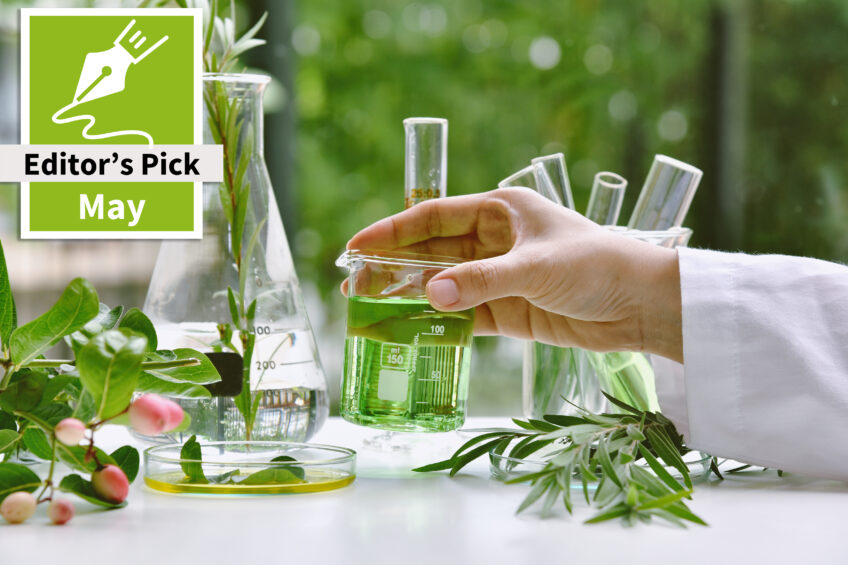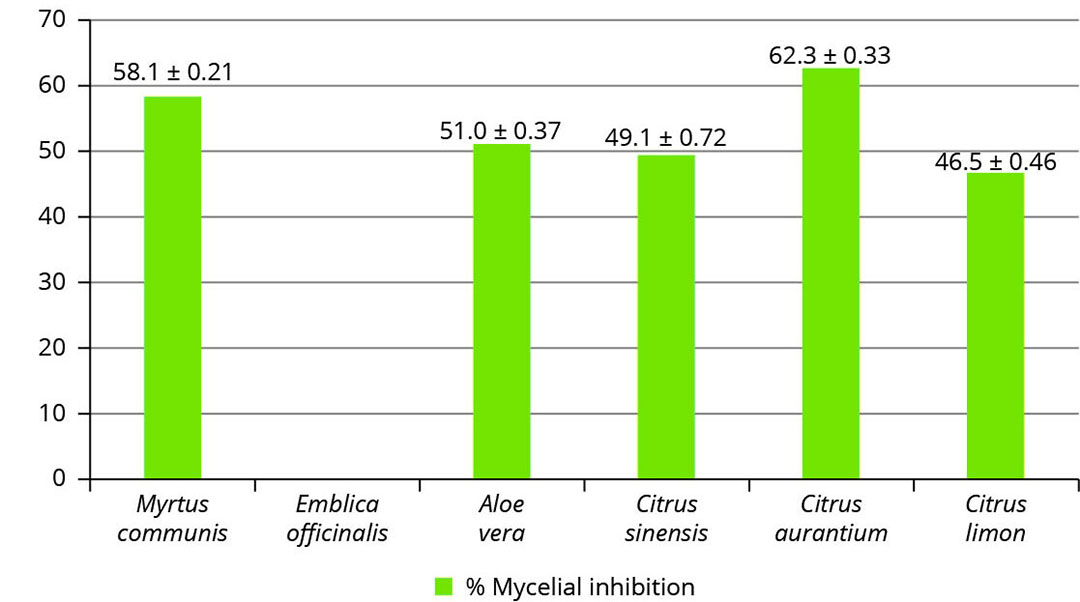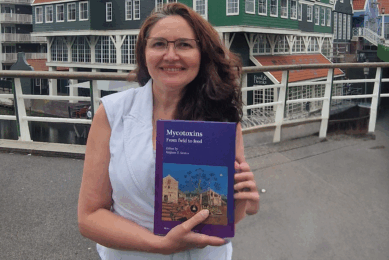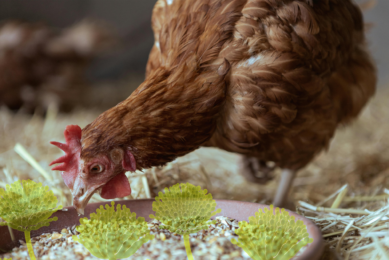Using plant extracts to combat mycotoxins in animal feed

A new study shows the efficacy of various plant extracts in counteracting mycotoxins found in animal feed. The plant extracts were extracted from aloe (Aloe vera), myrtle (Myrtus communis), sweet orange (Citrus sinensis), amla (Emblica officinalis), lemon (Citrus limon) and sour orange (Citrus aurantium).
Mycotoxin contamination is one of the main challenges to the safety of grains and other field crops around the globe. As a tool for combating mycotoxins, natural plants and plant extracts have captured the attention of the scientific community as they are environmentally friendly, biodegradable, and have antifungal and anti-mycotoxigenic properties. Previous studies point out that, for example, myrtle (Myrtus communis) has significant antifungal ability against fungi such as dermatophytes fungi. Numerous studies show noteworthy biological activity of Aloe vera in treating bacteria, viruses, and fungi such as Candida albican. On the other hand, citrus essential oils are reported to comprise a complex mixture of volatile compounds with strong antifungal activity.
The study
A study was carried out to evaluate the antifungal effect of aqueous extracts from the leaves of plants to inhibit or lower fungal growth and mycotoxins in animal feed samples. In the current study, six medicinal plants were used to investigate their antifungal and anti-mycotoxigenic capacity. For the analysis of mycotoxins in the feed samples, the thin layer chromatography (TLC) technique was used. The leaf extract of six selected plants of aloe (Aloe vera), myrtle (Myrtus communis), sweet orange (Citrus sinensis), amla (Emblica officinalis), lemon (Citrus limon) and sour orange (Citrus aurantium) were used to investigate their antifungal and anti-mycotoxigenic capacity. The antifungal activities were analysed by applying the disc diffusion method.
The zone of inhibition, minimum inhibitory concentration (MIC) and minimum fungicidal concentration (MFC) were measured against a range of different fungi. In addition, mycelial inhibition of A. flavus was checked for the plant extracts. The researchers also conducted a toxicological analysis of the feed samples: Feed samples were screened for the presence of aflatoxins B1, B2, G1 and G2; aflatoxin B1 was the most common, being found in all the feed samples, whereas aflatoxin G2 was the least common (it was only present in one sample).
Fungal flora of animal feed samples
To confirm the existence of fungi in feed, a plating technique was used and this confirmed the existence of a range of fungi species. Seven species of Aspergillus: A. parasiticus, A. flavus, A. niger, A. ochraceus, A. clavatus, A. fumigatus, A. carbonarius and three species of Penicillium: P. citrinum, P. verrucosum and P. notatum were obtained from feed samples. All ten feed samples were found to be positive for Aspergillus flavus while only one sample was positive for Aspergillus notaum. This prompted a further specific determination of the mycelial inhibition of A. flavus by the different extracts.
Antifungal activity of plant leaves’ aqueous extracts
The results of the study showed varying levels of efficacy of the plant extracts against the tested fungi. The highest activity was 13 ± 0 mm for Citrus sinensis against Aspergillus niger while Aloe vera was reported to have the least inhibition (07 ± 1 mm). Aspergillus niger and Citrus limon had no antifungal effect. In the case of Aspergillus flavus, the widest zone of inhibition (15 ± 1) was shown for Citrus aurantium, while the least activity (09 ± 1 mm) was shown for Citrus limon; Emblica officinalis had no effect. The activity of Citrus sinensis was highest (15 ± 0 mm) against Aspergillus parasiticus, and the lowest was that of Citrus limon (07 ± 1 mm) against the Aspergillus parasiticus.
MIC of plant leaves’ aqueous extracts
The MIC value of Citrus sinensis was 160 mg/ml against Aspergillus niger, while the MIC value of Citrus aurantium was 240 mg/ml against Aspergillus niger. In the case of Aspergillus flavus, Citrus aurantium exhibited MIC of 130 mg/ml, whereas Citrus limon had the highest MIC (210 mg/ml). Against Aspergillus parasiticus, the lowest MIC was observed in Citrus Sinensis (140 mg/ml) whereas the highest MIC was observed in Emblica officinalis (210 mg/ml). Against Aspergillus ochraceus the lowest MIC value was found in Citrus aurantium (110 mg/ml) whereas the highest MIC value was found in Emblica officinalis (210 mg/ml) and Aloe vera (210 mg/ml).
MFC of plant’s leaves aqueous extracts
The MFC value of the aqueous extracts of selected plants was performed by the microdilution method. In the case of Aspergillus niger, the MFC value was 180 mg/ml in Citrus sinensis, while the highest MFC value was noted in Aloe vera (240 mg/ml). In the case of Aspergillus flavus, Citrus aurantium showed the lowest MFC value of 150 mg/ml, whereas Citrus limon showed the highest MFC value of 230 mg/ml. In the case of Aspergillus parasiticus the least MFC value was shown by Citrus sinensis (160 mg/ml), while the highest MFC was observed in Emblica officinalis (290 mg/ml).
Mycelial inhibition of A. flavus
The antifungal activity of the aqueous extract of each plant was determined against A. flavus by poison food technique for the determination of mycelial inhibition. The result presented in Figure 1 shows that Citrus aurantium had the highest (62.3 ± 0.33) mycelial inhibition of A. flavus, followed by Myrtus communis, while the lowest mycelial inhibition was with Citrus limon (46.5 ± 0.46). Mycelial inhibition by Emblica officinalis was not detected.
Figure 1 – % Mycelial inhibition of A. flavus by selected plant extracts.

Concluding remarks
The results of this study show that all the aflatoxins, i.e., G1, G2, B1 and B2 were present in varying amounts in the feed samples. The highest quantity present was that of B1 while G2 was only present in one feed sample. Citrus aurantium and Myrtus communis were observed to have the highest antifungal potency against all tested fungi. Both Citrus aurantium and Myrtus communis extracts were also found to have the highest growth inhibition of the dominant or most prevalent Aspergillus flavus. The researchers recommend future research to investigate the proper genomic understanding of these mycotoxins in order to develop effective treatment therapy. “Furthermore, good surveillance and proper hygienic measures should always be implemented to reduce the likelihood of pathogenic contaminants in animal feed,” they said.
This article is based on an original publication by Raza Ullah, Isfahan Touseef, Rameesha Abid, Arshad Farid, Sohail Ahmad, Hesham Ali El Enshasy, Adil Aksoy, Nada H. Aljarba, Tahani Mohamed Al–Hazani, Muhammad Muzammal, and Shakira Ghazanfar. 2023. Exploitation of selected plant extracts as bio-control against fungal contaminants in animal feed. Journal of King Saud University, 35:102685.
A new study shows the efficacy of various plant extracts in counteracting mycotoxins found in animal feed. The plant extracts were extracted from aloe (Aloe vera), myrtle (Myrtus communis), sweet orange (Citrus sinensis), amla (Emblica officinalis), lemon (Citrus limon) and sour orange (Citrus aurantium).
Mycotoxin contamination is one of the main challenges to the safety of grains and other field crops around the globe. As a tool for combating mycotoxins, natural plants and plant extracts have captured the attention of the scientific community as they are environmentally friendly, biodegradable, and have antifungal and anti-mycotoxigenic properties. Previous studies point out that, for example, myrtle (Myrtus communis) has significant antifungal ability against fungi such as dermatophytes fungi. Numerous studies show noteworthy biological activity of Aloe vera in treating bacteria, viruses, and fungi such as Candida albican. On the other hand, citrus essential oils are reported to comprise a complex mixture of volatile compounds with strong antifungal activity.
The study
A study was carried out to evaluate the antifungal effect of aqueous extracts from the leaves of plants to inhibit or lower fungal growth and mycotoxins in animal feed samples. In the current study, six medicinal plants were used to investigate their antifungal and anti-mycotoxigenic capacity. For the analysis of mycotoxins in the feed samples, the thin layer chromatography (TLC) technique was used. The leaf extract of six selected plants of aloe (Aloe vera), myrtle (Myrtus communis), sweet orange (Citrus sinensis), amla (Emblica officinalis), lemon (Citrus limon) and sour orange (Citrus aurantium) were used to investigate their antifungal and anti-mycotoxigenic capacity. The antifungal activities were analysed by applying the disc diffusion method.
The zone of inhibition, minimum inhibitory concentration (MIC) and minimum fungicidal concentration (MFC) were measured against a range of different fungi. In addition, mycelial inhibition of A. flavus was checked for the plant extracts. The researchers also conducted a toxicological analysis of the feed samples: Feed samples were screened for the presence of aflatoxins B1, B2, G1 and G2; aflatoxin B1 was the most common, being found in all the feed samples, whereas aflatoxin G2 was the least common (it was only present in one sample).
Fungal flora of animal feed samples
To confirm the existence of fungi in feed, a plating technique was used and this confirmed the existence of a range of fungi species. Seven species of Aspergillus: A. parasiticus, A. flavus, A. niger, A. ochraceus, A. clavatus, A. fumigatus, A. carbonarius and three species of Penicillium: P. citrinum, P. verrucosum and P. notatum were obtained from feed samples. All ten feed samples were found to be positive for Aspergillus flavus while only one sample was positive for Aspergillus notaum. This prompted a further specific determination of the mycelial inhibition of A. flavus by the different extracts.
Antifungal activity of plant leaves’ aqueous extracts
The results of the study showed varying levels of efficacy of the plant extracts against the tested fungi. The highest activity was 13 ± 0 mm for Citrus sinensis against Aspergillus niger while Aloe vera was reported to have the least inhibition (07 ± 1 mm). Aspergillus niger and Citrus limon had no antifungal effect. In the case of Aspergillus flavus, the widest zone of inhibition (15 ± 1) was shown for Citrus aurantium, while the least activity (09 ± 1 mm) was shown for Citrus limon; Emblica officinalis had no effect. The activity of Citrus sinensis was highest (15 ± 0 mm) against Aspergillus parasiticus, and the lowest was that of Citrus limon (07 ± 1 mm) against the Aspergillus parasiticus.
MIC of plant leaves’ aqueous extracts
The MIC value of Citrus sinensis was 160 mg/ml against Aspergillus niger, while the MIC value of Citrus aurantium was 240 mg/ml against Aspergillus niger. In the case of Aspergillus flavus, Citrus aurantium exhibited MIC of 130 mg/ml, whereas Citrus limon had the highest MIC (210 mg/ml). Against Aspergillus parasiticus, the lowest MIC was observed in Citrus Sinensis (140 mg/ml) whereas the highest MIC was observed in Emblica officinalis (210 mg/ml). Against Aspergillus ochraceus the lowest MIC value was found in Citrus aurantium (110 mg/ml) whereas the highest MIC value was found in Emblica officinalis (210 mg/ml) and Aloe vera (210 mg/ml).
MFC of plant’s leaves aqueous extracts
The MFC value of the aqueous extracts of selected plants was performed by the microdilution method. In the case of Aspergillus niger, the MFC value was 180 mg/ml in Citrus sinensis, while the highest MFC value was noted in Aloe vera (240 mg/ml). In the case of Aspergillus flavus, Citrus aurantium showed the lowest MFC value of 150 mg/ml, whereas Citrus limon showed the highest MFC value of 230 mg/ml. In the case of Aspergillus parasiticus the least MFC value was shown by Citrus sinensis (160 mg/ml), while the highest MFC was observed in Emblica officinalis (290 mg/ml).
Mycelial inhibition of A. flavus
The antifungal activity of the aqueous extract of each plant was determined against A. flavus by poison food technique for the determination of mycelial inhibition. The result presented in Figure 1 shows that Citrus aurantium had the highest (62.3 ± 0.33) mycelial inhibition of A. flavus, followed by Myrtus communis, while the lowest mycelial inhibition was with Citrus limon (46.5 ± 0.46). Mycelial inhibition by Emblica officinalis was not detected.
Figure 1 – % Mycelial inhibition of A. flavus by selected plant extracts.

Concluding remarks
The results of this study show that all the aflatoxins, i.e., G1, G2, B1 and B2 were present in varying amounts in the feed samples. The highest quantity present was that of B1 while G2 was only present in one feed sample. Citrus aurantium and Myrtus communis were observed to have the highest antifungal potency against all tested fungi. Both Citrus aurantium and Myrtus communis extracts were also found to have the highest growth inhibition of the dominant or most prevalent Aspergillus flavus. The researchers recommend future research to investigate the proper genomic understanding of these mycotoxins in order to develop effective treatment therapy. “Furthermore, good surveillance and proper hygienic measures should always be implemented to reduce the likelihood of pathogenic contaminants in animal feed,” they said.
This article is based on an original publication by Raza Ullah, Isfahan Touseef, Rameesha Abid, Arshad Farid, Sohail Ahmad, Hesham Ali El Enshasy, Adil Aksoy, Nada H. Aljarba, Tahani Mohamed Al–Hazani, Muhammad Muzammal, and Shakira Ghazanfar. 2023. Exploitation of selected plant extracts as bio-control against fungal contaminants in animal feed. Journal of King Saud University, 35:102685.











